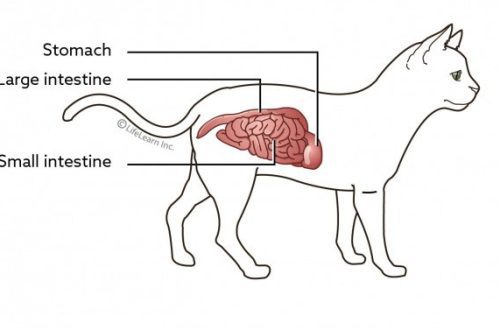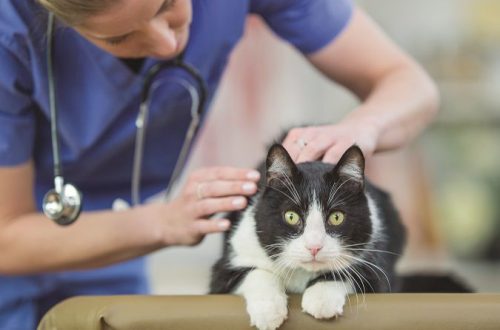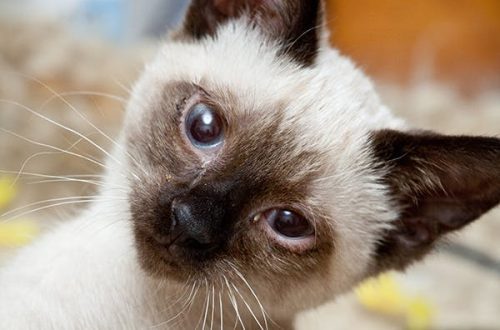
The cat has watery eyes – why and what to do?
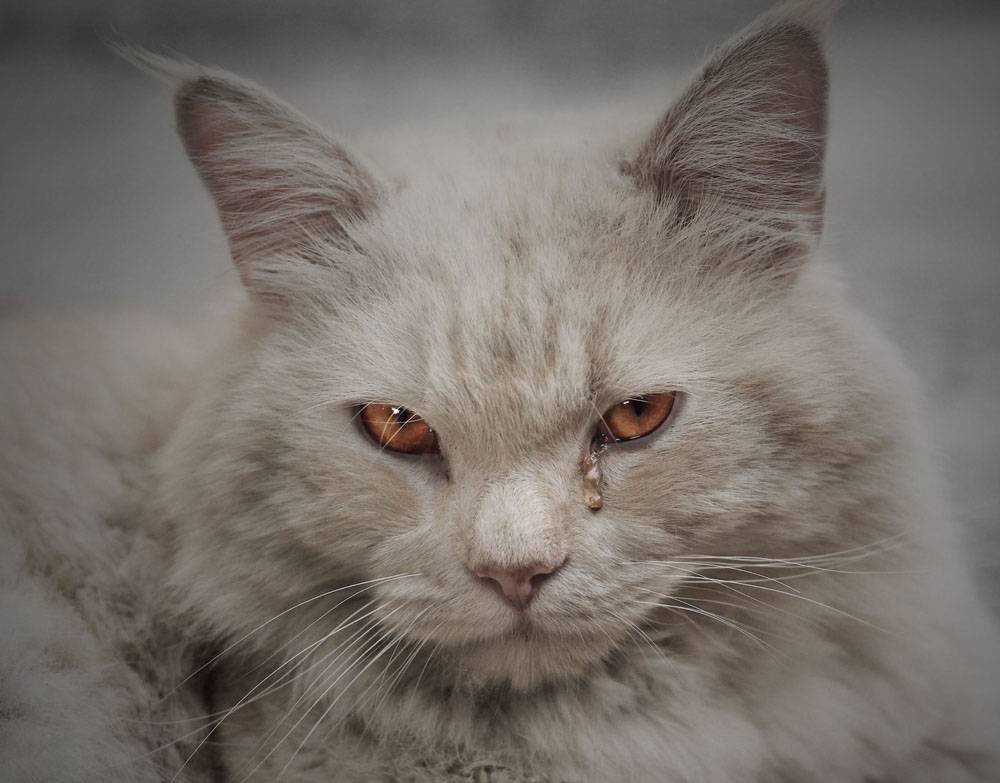
Tears are a chemical solution made up of water, lipids (fats), and mucin (mucus). They are necessary for wetting the eye and protecting it, cleansing the cornea and conjunctiva.
The eyes of a healthy cat are bright, clear and transparent. You should be able to clearly see the pupil (black) and iris (colored part).
If you notice occasional, clear, watery discharge from your pet’s eye, it may not be something to worry about. But if they recur regularly, persist, turn yellow or sticky, then this is cause for concern. Signs of ill health include blurred eyes, itching or excessive blinking, and squinting.
In the article we will tell you what could be the reasons why a cat has watery and flowing one eye or both, what to do and what treatment to use.
Contents
- Why do cats have watery eyes?
- Why does a cat have a watery and flowing one eye?
- Additional symptoms
- Diagnosis of pathologies
- What to do if the cat’s eyes are watery and flowing?
- Problem prevention
- If the kitten’s eyes are watery
- The cat’s eyes are flowing – the main thing
- Answers to frequently asked questions
Why do cats have watery eyes?
Increased tear production is called epiphora. It can be due to a number of factors, from overproduction of tears or allergies to infections or a foreign body lodged in your pet’s eye.
Tears are a protective reaction of the eye. Increased tear production indicates that the eye is in pain, and something is preventing it from functioning normally.
Viral infections
Upper respiratory tract infections in cats cause runny nose and watery eyes along with general feelings of lethargy and malaise.
The most common is feline herpesvirus, calicivirus infection. Viral diseases are transmitted by airborne droplets and affect the mucous membranes of the nose, mouth and eyes.
Allergy
Just like humans, domestic cats can be allergic to a range of things, including dust and pollen, and crying eyes can be a sign of such a condition. As a rule, in addition to watery eyes, a cat with allergies has other signs: they scratch their eyes, lick themselves hard and have skin lesions.
Conjunctivitis
Conjunctivitis is an inflammation of the pink mucous membrane surrounding a cat’s eyes. Inflammation of the conjunctiva may appear as a result of the development of a viral or bacterial infection, the penetration of an allergy. The discharge associated with this may be clear and watery or thick and yellow. Eyes redden, swollen.
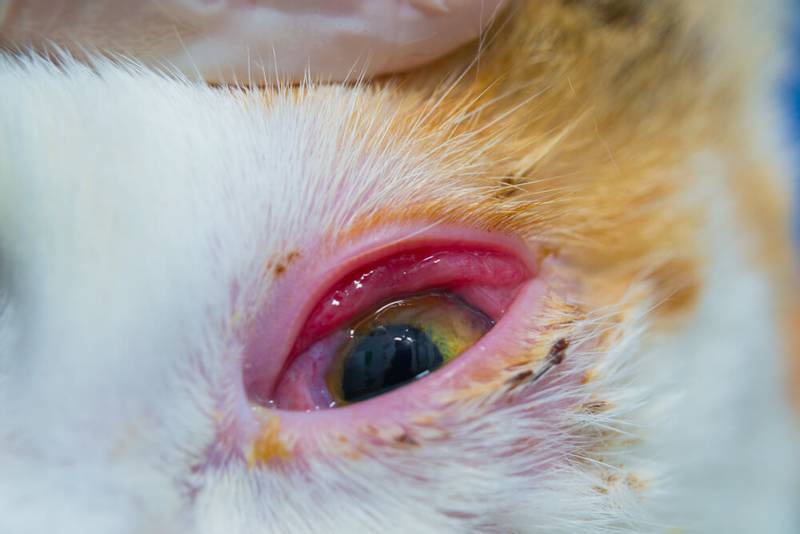
Chemical burn
Lachrymation can cause toxic substances, volatile and liquid. Substances with a pungent odor can provoke irritation and profuse lacrimation. In addition, if chemicals – shampoo, soap, disinfectants – get into the eyes, they can cause chemical burns, severe pain and, as a result, increased tear production.
Pathology of the nasolacrimal canals
The nasolacrimal duct is a structure that starts at the lacrimal puncta in the inner corner of the eye and runs under the skin along the back of the nose to end in the nose. Through the channel, excess tears flow into the nose. There are many things that can lead to blocked tear ducts, but the most common ones tend to be dust or mucus. Also, some cats may not have a canal since birth, or may have closed lacrimal openings as a result of prolonged inflammation. Tears cannot properly drain from your pet’s eyes when these ducts are blocked and this results in eyes that are always wet and tear ducts appear on the nose. The problem can affect both eyes and one.
Inflammation of the choroid – uveitis
From the inside, the eyeball is lined with vessels like a cobweb. If the infection penetrates the eye, inflammation of the choroid begins, and this is called uveitis.
Inflammation can cause surges in intraocular pressure, cloudiness of the intraocular fluid, pus, and hemorrhages inside the eye. Uveitis is accompanied by pain and increased tear production, which can cause watery eyes in the cat.
Breed predisposition
There are no cat breeds for which epiphora is considered normal. However, there are a number of breeds that most often experience this problem due to the structure of the eye.
These breeds include brachycephals (exotics, Persian breed) and breeds with round bulging eyes – British, Scottish cats.
These breeds of cats blink much less often and do not always close the eyelids when blinking, as a result of which the cornea of uXNUMXbuXNUMXbthe eye can dry out, and an increased amount of tears is produced as compensation.
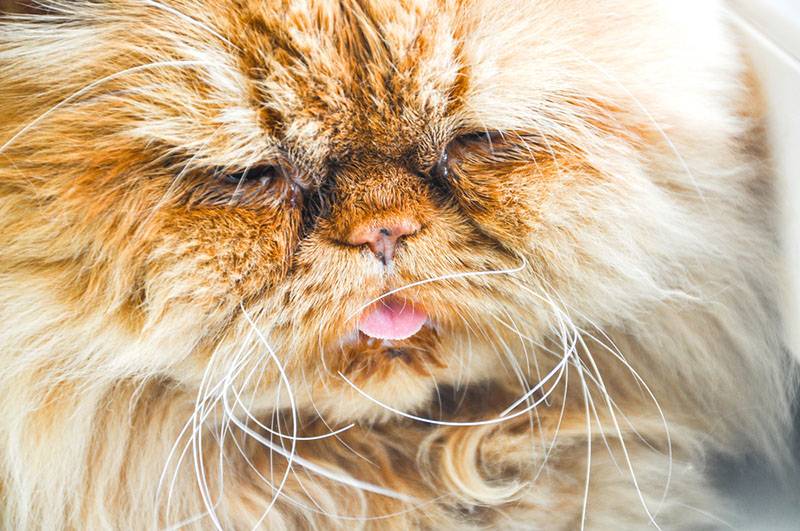
Why does a cat have a watery and flowing one eye?
There are a number of pathologies, as a result of which epiphora can be from one eye. If a cat has a watery eye, this usually indicates a mechanical cause of injury, a foreign body, a pathology of the eyelids that disturbs the eye.
Corneal injury
These include any injury that violates the integrity of the cornea – ulcers, deep lesions and erosion on the surface. They are incredibly painful and need immediate treatment to prevent further damage to the eye, infection that may require surgery.
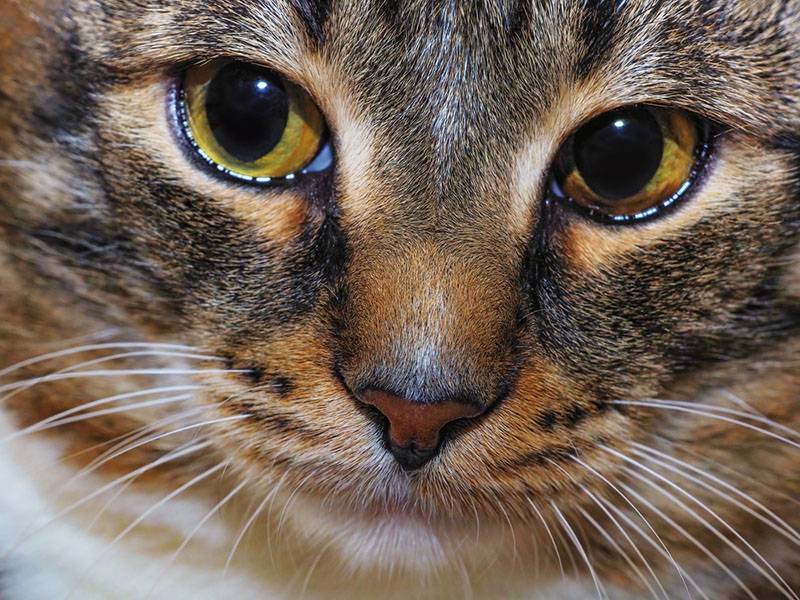
Foreign body
The most common foreign body in the eye tends to be grass seeds, especially in late summer and fall. They most often fall under the third eyelid, causing irritation that leads to increased tear production.
Entropion
Inversion of the eyelids is a disease in which the edge of the eyelids is wrapped inside the eye, the edge of the eyelid and the hair rub the cornea. This causes pain and discomfort. With prolonged friction, the cornea is injured, and ulcers appear. The most predisposed breeds are the Sphynx, British cats and Maine Coons.
Luxation of the lens
Behind the pupil, inside the eye, the lens is attached. The lens is a dense structure, in the form of a lens, that changes its curvature to adapt the eye when focusing vision on distant or near objects. It is suspended from two poles. As a result of injury, genetic predisposition, or just a coincidence, the muscles can tear, and the lens luxes (comes off) into the anterior or posterior chamber of the eye. This causes pain and discomfort, intraocular pressure surges, resulting in a watery eye in the cat.
Glaucoma
A persistent increase in intraocular pressure is called glaucoma. As a result, the eye can increase in size, put pressure on the internal and external structures of the eye, hurt and, as a result, go blind.
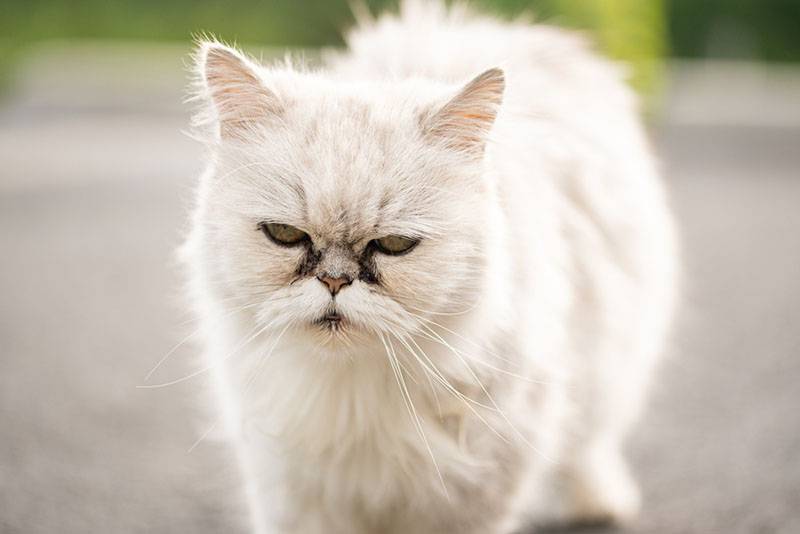
Neoplasms
Tumors inside the eye, behind the orbital space of external structures, disrupt the normal functioning of the eye, as a result of which there is an increased production of tears.
Additional symptoms
In addition to the fact that the cat’s eyes are flowing, the disease may be accompanied by other symptoms:
Blepharospasm is a condition where a cat cannot open its eyes. A frequent symptom with acute pain in the eyes, injuries, foreign bodies.
Enophthalmos is a condition in which the eye is retracted into the orbit from its normal position. It accompanies such pathologies as uveitis, inversion of the eyelid, trauma.
Exophthalmos – protrusion of the eye from the orbit – accompanies pathologies in which the eye increases in size – glaucoma, uveitis, lens luxation, tumors.
Hyperemia and chemosis of the conjunctiva – redness and swelling of the mucous membrane of the eye – occurs with the development of conjunctivitis, the penetration of viruses and bacteria.
Vascularization – the germination of blood vessels in the cornea – accompanies corneal injuries, inflammatory eye diseases.
Cloudy eyes can accompany any eye disease.
A change in the color of the iris occurs as a result of inflammatory diseases inside the eye – uveitis, luxation, glaucoma and neoplasms.
Change in the nature of the discharge from transparent to cloudy, yellow, sticky green. This indicates the accession of an infection or the development of a virus.
Sneezing and coughing are the main symptom of viral diseases in cats that affect the upper respiratory tract.
Decreased appetite, activity often accompanies conditions that cause pain and fever.
Itching of the eyes accompanies viral diseases, allergies, conjunctivitis, foreign bodies, entropion.
All symptoms need your reaction and seeking help.
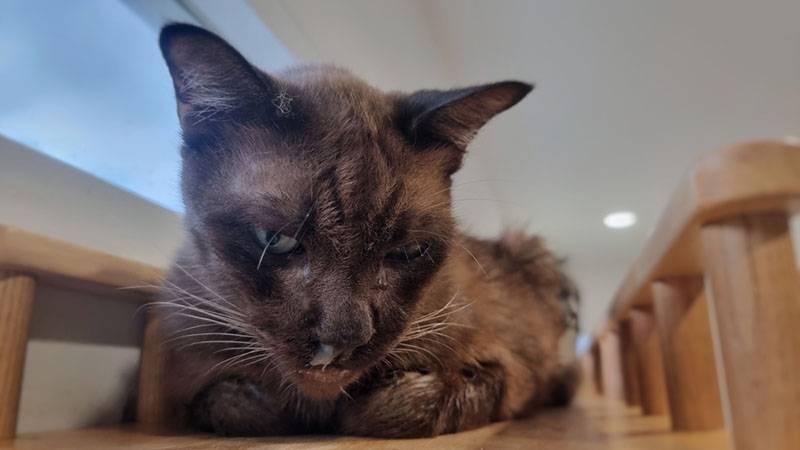
Diagnosis of pathologies
In order to determine the reason why the cat has watery eyes, it is necessary to conduct an ophthalmological examination.
At the appointment, the doctor will carefully examine the eyes and eyelids, including under a magnifying glass. Most pathologies can be easily seen with proper lighting and magnification – entropion, lens luxation, inflammation of the conjunctiva and foreign bodies.
The doctor will also check visual reflexes, pupil contraction to light, corneal sensitivity. As necessary, tests are carried out to gradually exclude a particular cause. They may include:
Corneal staining with fluorescein – this will determine if there is damage to the cornea
Test for the patency of the nasolacrimal ducts – the tear is stained and waited for a while, normally it should go through the nasolacrimal duct into the nose
Intraocular pressure measurement
Examination of the fundus with an ophthalmoscope – allows you to assess the presence of inflammation and the state of the choroid
Ultrasound of the eye – necessary to assess the position of the lens and the presence of neoplasms
Taking swabs from the eyes for PCR diagnostics for the detection of viruses.
In addition, a general clinical examination in the form of blood tests may be recommended to assess the condition of the internal organs, the degree of the inflammatory process.
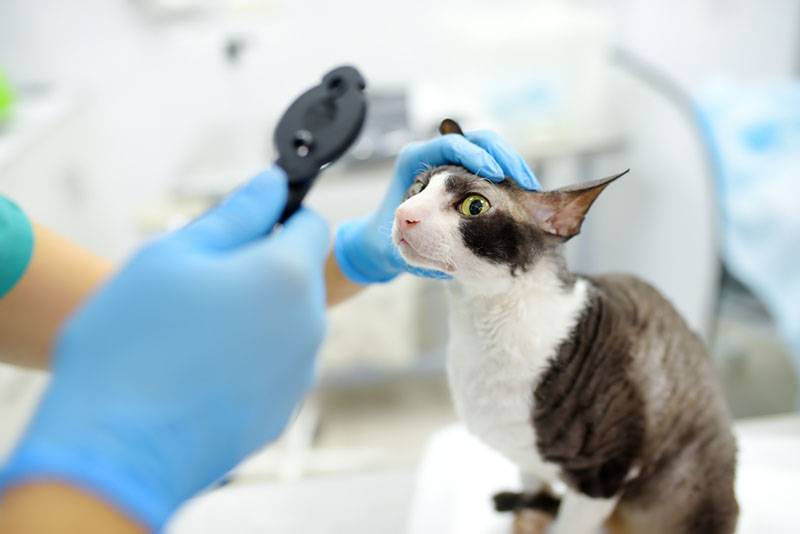
What to do if the cat’s eyes are watery and flowing?
So, how and how to treat a cat, if her eyes are watery and flowing, are determined based on the causes found. For example, if the cause is in a foreign body, it is enough to simply remove it.
With the development of inflammatory processes, due to the penetration of viruses or bacteria, drops or ointments are prescribed in the eyes with an antibiotic and symptomatic drugs inside. Treatment of such pathologies is complex and lengthy. These diseases include conjunctivitis, uveitis, feline herpesvirus and others.
If the cause of lacrimation is the pathology of the nasolacrimal canals, then the therapy is not effective and minimally invasive surgery is required – washing the canals, restoring the lacrimal openings or bougienage (installation of a flexible fishing line in the canals).
For the healing of ulcers and erosions, the use of local drops will be required – with an antibiotic, keratoprotectors (tear substitutes), in rare cases, anti-inflammatory drops. Drugs are most often prescribed medical. And in no case should you use drugs that contain hormones (dexamethasone, prednisolone).
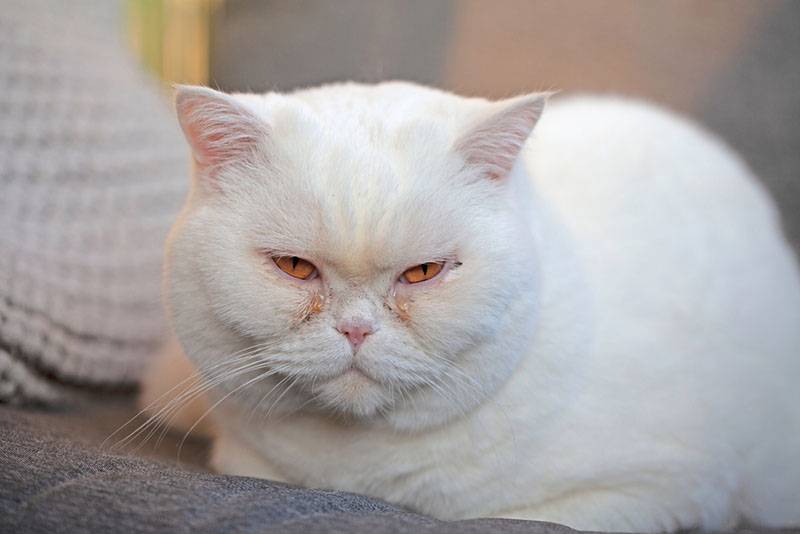
For the treatment of glaucoma, they try to eliminate its cause, prescribe drugs to reduce intraocular pressure and diuretics. If therapy fails, then surgical treatment of glaucoma or removal of the eye is required.
In case of contact with the eyes of chemical components, abundant rinsing of the eyes with water or saline, instillation of keratoprotectors is required.
For the treatment of allergies, a phased exclusion of all possible causes is carried out, that is, treatment for parasites, a hypoallergenic diet. There are no tests to determine a specific type of allergy.
Only surgically it is possible to eliminate a number of problems – inversion of the eyelids, luxation of the lens.
Problem prevention
In order to prevent eye diseases, regularly examine the cat’s muzzle. If you find discharge, changes in the color of the hair around the eyes, redness, make an appointment with a doctor.
To prevent viral infections, treat your cat regularly for parasites and vaccinate.
To avoid injury, exclude self-walking, cut the claws of cats living together.
Control your pet’s diet, stick to a monotonous and balanced diet.
If your cat is unable to do eye care on his own, bathe him regularly and clean his coat with warm water or eye lotions.
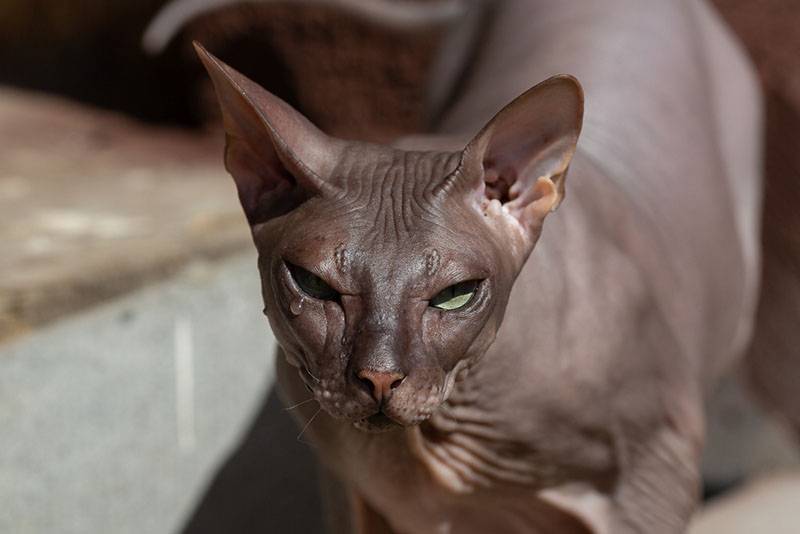
If the kitten’s eyes are watery
A kitten may have watery eyes as a result of the development of viral infections, problems with the nasolacrimal ducts, less often – as a result of congenital pathologies – entropion.
Feline herpes is a contagious virus. There are many different symptoms of feline herpes. Most can last two to three weeks, but the virus can lie dormant inside a cat’s body for many months.
Upper respiratory tract infections may include symptoms such as eye discharge, eye redness, sneezing, nasal discharge, drooling, cough, fever, loss of appetite.
If left untreated, keratitis (inflammation of the cornea), ulcers, and inflammation of the anterior chamber of the eye develop.
In addition, a kitten that has become infected with an infection at a very early age develops adhesions of the conjunctiva with the cornea – symblepharon. This requires surgical correction and causes constant discomfort, pain and tearing.
If you have any symptoms of infection, you need to see a doctor as soon as possible in order to avoid irreversible consequences.
If a kitten has a watery eye in one eye, and this arose gradually, then most likely he has problems with the nasolacrimal ducts. Often in young animals, blockage of the canal is caused by birth mucus that gets there at birth, dust and wool. And if the symptoms developed abruptly, and the kitten lives with other cats, then it is worth examining the eyes for corneal injuries.
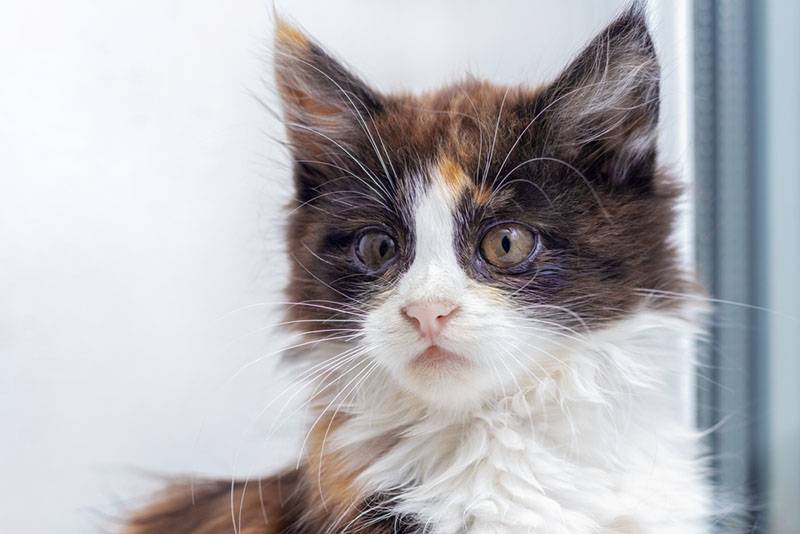
The cat’s eyes are flowing – the main thing
Increased tear production is a protective reaction of the eye to pain, discomfort, or the presence of pathologies in the tear drainage system.
If, in addition to epiphora, there are other symptoms – pain, redness, itching – you should immediately consult a doctor.
In order to determine the cause and prescribe treatment, an ophthalmological examination and tests are required.
Treatment can be topical orally and surgically, depending on the cause.
A number of pathologies carry a cosmetic defect and do not lead to serious health problems – blockage of the nasolacrimal canal, breed characteristics. Other causes can lead to irreversible consequences and require urgent treatment.
If the eyes of a kitten are watery, the most common causes are associated with the development of viral infections or pathologies of the nasolacrimal canal, treatment should be started as early as possible.
Answers to frequently asked questions
Sources:
Lebedev A. V. “Veterinary ophthalmology”, 2004
Riis R.K. Small Animal Ophthalmology, 2018



